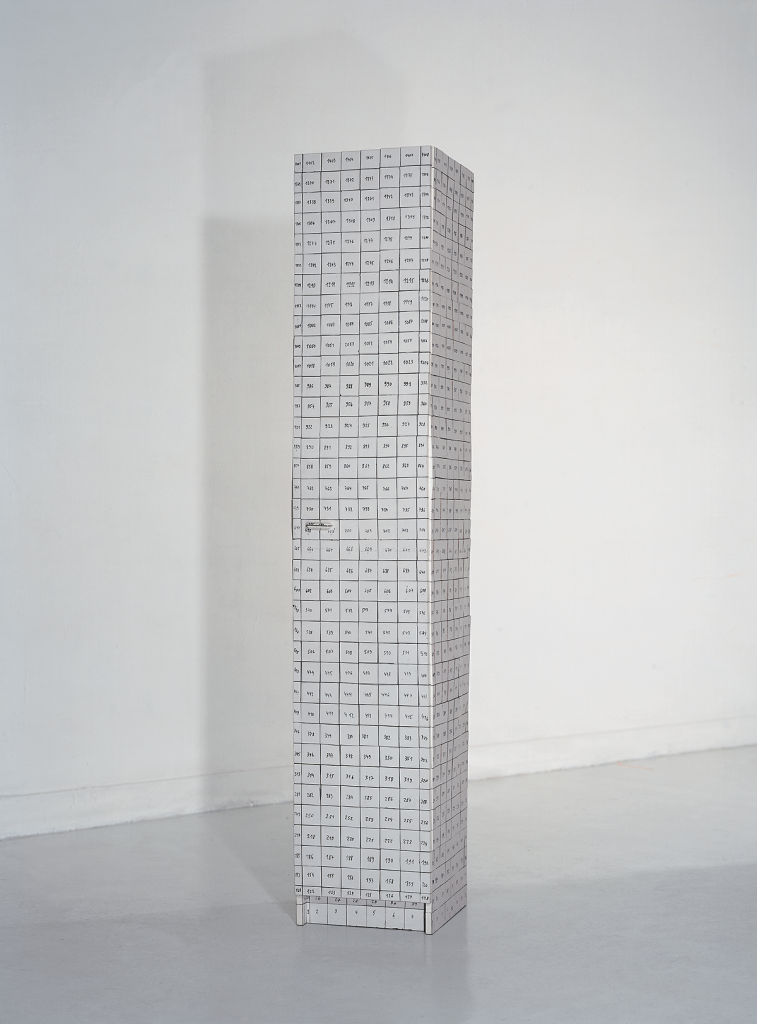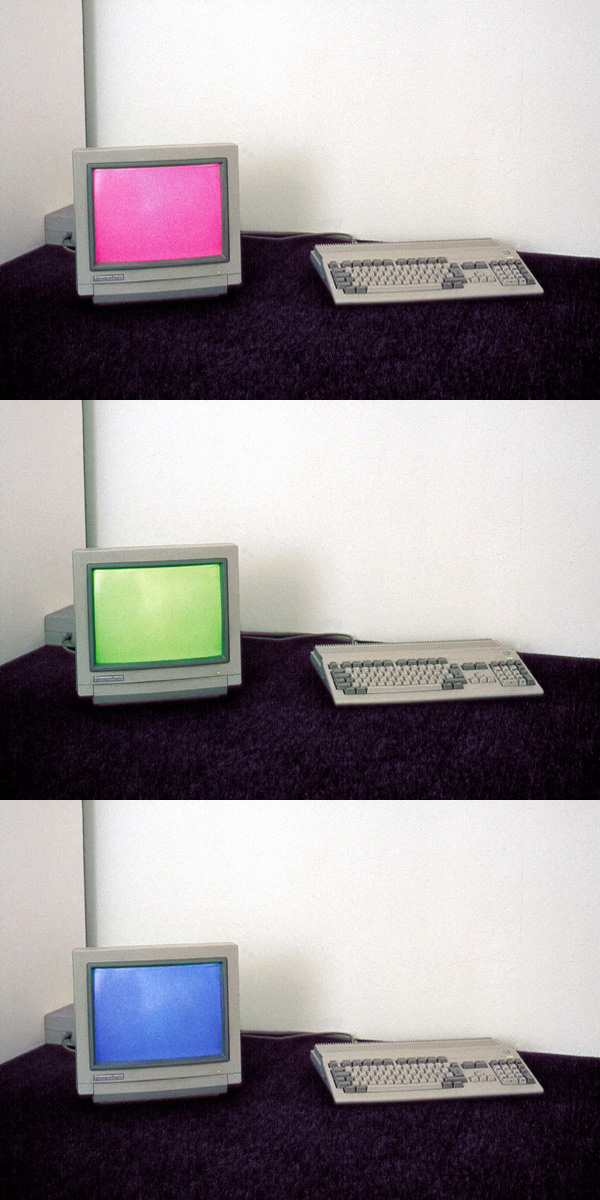(Monochromes) pictures at a (computerized) exhibition
Hervé Laurent (in cat. 5ème SIV, St-Gervais, Geneva – 1993)
The work of Hervé GRAUMANN (H.G.) runs across the categories which govern our relationship with the world of phenomena with a kind of serene indifference whose effects are, often, not devoid of irony. This remoteness from the existential burden which usually gives weight to the reasons adduced for our judgment, the analyses and the actions which result from it, H.G. owes to the privileged relationship which he has had from the outset with computer logic. This logic, of whose binary nature we are reminded sufficiently often to render any dwelling on it unnecessary, is further distinguished by the fact that it deals with an order of reality which we could describe as homogeneous and granular. Pixel, 0/1, …from the heart of the machine to the flickering light of the screens, the informational universe which the computer manages is formed entirely of identical elements, sorts of fractions whose final configuration can produce an image, a sound, a line of reasoning, the result of a calculation, etc., that is, so many events and figures recalling the web of our daily round. The result is that, deceived by this coincidence, we have become accustomed to attributing to the computer an intentionality directed toward real life, whereas it is the set of operating necessities readable through our user strategies alone which is responsible for such an, in fact, wholly unfounded similarity.
H.G. works in this breaking-up area whose consequences he strives to explore. First, by reducing it to the absurd, by applying the technique of its computerized keyboarding to the object itself. So we have furniture cut-up and glued together again, which we can describe as having been violently pixelized, or, again, part of an object is moved bit by bit into another object, as if the integrity of the wholes from which these parts were extracted were no longer a determining element to be taken into account in the intervention protocol. The copy/glue functions, then, without fear of creating monsters, so true it is that monstrosity is the result of heterogeneity – the centaur is a fine example of this, as are the fabled animals which peopled the medieval imaginary – and that here, once we have accepted that the uniform substance of the computer universe is going to be attributed to reality, this automatic reservation should be ignored. In other words, H.G. confronts qualitative metaphysics with a purely quantitative approach and humorously plays the theory of the grain of sand against that of the sand castle. The text is only possible if we refuse the domination of the texture. The humour innate in several of H.G.’s works lies in that he tries to have both, letting the repetitive structure of the computer grain invade the prose of the world and disrupt it.

…de l’ordre alphabétique des couleurs (dladc base v1.1) – table en 7 langues & 11 couleurs classées par ordre alphabétique
It is the same kind of approach which leads him to work this prose over, not bowing to the narrative or analytical order which it constructs throughout its various segments, but like a multi-entry picture which can be consulted as a database. On a form of selection proper to the tale and not very directly explicit, H.G. superimposes a form of classification with very strictly defined criteria. So taking colour not as a theme but as a general chapter heading, the artist is induced to draw up the list of a town’s telephone subscribers whose names are colours, or else to paint a picture which is neither conceptual nor neo-geo but the consequence of a double-listing; horizontally a series of languages, vertically the names ofsome colours previously chosen and placed in alphabetical order. The coordinates so defined make it possible to compose a set of coloured squares which, when put together, simply make up the picture. The same approach also ends with the painting of a monochrome canvas in the presence of a person whose name indicates the colour used. Mr. RED, Mrs. PINK, are then invited to sign the minutes on the session. Messrs. Damien and Alberto BLANC (WHITE), more obliging, even agreed to be introduced, then to have their photograph taken, the former balancing on the shoulders of the latter for a composition (in black and white…) judiciously entitled “Blanc sur Blanc” (White on White).
COULEUR-MINUTE belongs to this group of works constructed around a problem using colour as the pretext. Its simplicity helps give a clear idea of the essence of H.G.’s work. It involves a bottom-of-the range Amiga computer, with a monitor continuously showing a random advertisement on the range of 4096 colours available with this sort of machine. Each minute, a colour chosen at random appears, to the exclusion of any other identifying element such as a menu or icon.
No sound accompanies this presentation. So, then, during a handful of seconds, each one of the colours exists on the screen occupying the entire surface and creating a kind of new and ephemeral monochrome picture which constitutes one moment of a computer-guided exhibition. The edge of the screen becomes the frame indicating the pictorial quality of the colour. In a half-light, the photonics mark out, minute after minute, a trembling band of coloured light, uniform but unstable, with low radiation. Its character as an apparition, whence it draws its specific aura is also the result of the brevity of this presence; we have moved from the grain of sand to the more complex metaphor of the sandglass. What we should understand is, I think, that H.G.’s work, under its obvious poetic quality, is first of all a reflection on the linking of the computer tool, nowadays prolonged by all its media appendices (by virtue of the interface), with our understanding of the world. To conclude, this exhibition coldly professes to be what it is; a series of moments whose duration is calibrated and whose sequential order calculated by a random function. In this respect, we can further say that our relationship was sensitive to the result but provided that we do not forget that its origin lies in the performance of the lines of a programme in which it is never a question of our view and that as a result, unlike the humanist thought of Marcel Duchamp, the viewers no longer make the pictures.
Text by Hervé Laurent (in cat. 5ème SIV, St-Gervais, Geneva – 1993)

